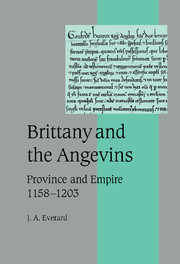Book contents
- Frontmatter
- Contents
- List of figures and maps
- Preface
- List of abbreviations
- Genealogy of the dukes of Brittany, 1066–1203
- The principal political divisions of Brittany, c. 1066
- Ducal domains, c. 1066–1186
- Introduction
- 1 Ducal Brittany, 1066–1166
- 2 Henry II and Brittany
- 3 The government of Brittany under Henry II
- 4 Duke Geoffrey and Brittany, 1166–1186
- 5 Duke Geoffrey, Henry II and the Angevin empire
- 6 The end of Angevin Brittany, 1186–1203
- Conclusion
- Appendices
- 1 The ‘Assize of Count Geoffrey’
- 2 The hereditary seneschals of Rennes
- 3 Angevin officers in Brittany
- 4 The right of Wreck and ducal brefs de mer
- Bibliography
- Index
- Cambridge Studies in Medieval Life and Thought Fourth series
4 - The right of Wreck and ducal brefs de mer
Published online by Cambridge University Press: 15 December 2009
- Frontmatter
- Contents
- List of figures and maps
- Preface
- List of abbreviations
- Genealogy of the dukes of Brittany, 1066–1203
- The principal political divisions of Brittany, c. 1066
- Ducal domains, c. 1066–1186
- Introduction
- 1 Ducal Brittany, 1066–1166
- 2 Henry II and Brittany
- 3 The government of Brittany under Henry II
- 4 Duke Geoffrey and Brittany, 1166–1186
- 5 Duke Geoffrey, Henry II and the Angevin empire
- 6 The end of Angevin Brittany, 1186–1203
- Conclusion
- Appendices
- 1 The ‘Assize of Count Geoffrey’
- 2 The hereditary seneschals of Rennes
- 3 Angevin officers in Brittany
- 4 The right of Wreck and ducal brefs de mer
- Bibliography
- Index
- Cambridge Studies in Medieval Life and Thought Fourth series
Summary
In view of how little contemporary sources disclose of ducal or seignorial administration in twelfth-century Brittany, there is a comparatively large amount of evidence concerning the customary right of wreck. This is reflected in the variety of terms, Latin and vernacular, employed by the clerks (naufragium, fractura navium, varech, lagan[us], bris). Although common throughout the pays de coutume, wreck must have had a special significance in Brittany with its extensive coastline, much of it rocky and treacherous, and its position on a shipping route dominated by the wine-trade. The use and abuse of wreck was a such a significant phenomenon in Breton society that it was one of the matters raised at an ecclesiastical council convened at Nantes by Hildebert, archbishop of Tours, with the co-operation of Duke Conan III, and was consequently condemned by Pope Honorius II.
Evidence of the exercise of the right of wreck from the late twelfth century suggests this ecclesiastical censure had little effect. Even the clergy, both secular and regular, continued to exercise it. In the inquest conducted on behalf of the archbishop of Dol in 1181, wreck is repeatedly mentioned in the same context as the seignorial right to ‘great fish’ from the sea. In the 1190s, the ducal seneschal of the Broërec determined a dispute over a shipwreck on the shores of Belle-Ile (Morbihan) in which the abbey of Sainte-Croix de Quimperlé claimed right of wreck.
- Type
- Chapter
- Information
- Brittany and the AngevinsProvince and Empire 1158–1203, pp. 213 - 215Publisher: Cambridge University PressPrint publication year: 2000



